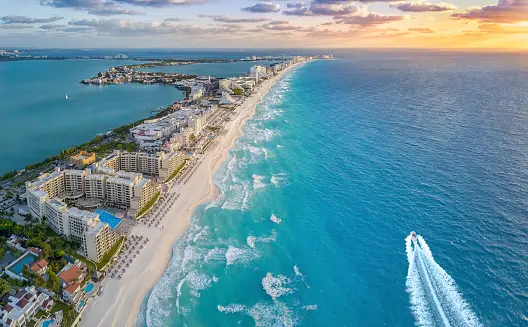Welcome to WordPress. This is your first post. Edit or d
Mexico Travel Guide ![]()
![]()
![]()
The home of tacos, aztecs, sombreros and tequila!
One of the largest cultures in the world, a fascinating blend of Mesoamerican cultures, Spanish traditions and contemporary arts.
Its scenery ranges from the shimmering blue coastline of Baja California to the cacti-clad deserts of the north, to the Mayan villages and palm groves of the south. You can climb volcanoes, visit ancient pyramids, watch whales and tour agave farms (the plant from which tequila is made).
Some facts about Mexico:
Population: 122 million.
Sources: Over 80 percent of the population are from Stizo, which in itself combines European and indigenous traditions.
Size: 1.96 million square kilometers.
Currency: Mexican peso
Dog Life: The Chihuahua is officially the smallest dog breed in the world and is actually named after the Mexican state of Chihuahua.
Movies: The opening scenes of one of the James Bond movies, closed Zokalo in central Mexico City for 10 days and included 1,500 extras (mostly dressed as Day of the Dead celebrants).
Artistic Legacy: Mexico has a variety of home talents, including Selma Hayek and Frida Kahlo.
Culinary Creatures: Bugs have been culinary delicacies in Mexico since the days of the Aztecs, with some of the most popular cockroaches (a type of cockroach), chickpeas (flying ants) and escamoles (ant larvae and pupae).
Where to go in Mexico:
This incredibly diverse country stretches from the deserts and canyons of the north to the large colonial cities of the center and the Mayan ruins, beaches and jungles of the south. Given the vast breadth of Mexico, it makes more sense and is more rewarding to concentrate on one or two sections of the country when planning your trip.
Here are some of the best places to visit in Mexico:
The capital city is Mexico City
Mexico City, despite the nightmare of urban sprawl creating insane traffic jams, is utterly fascinating, and the nation’s capital in every way – artistically, politically, culturally. It is one of the mega cities in the world, with over 25 million people.
The city is expanding beyond the federal district that is supposed to contain it. Around the city lie major remains of the pre-Hispanic cultures of central Mexico: the massive pyramids of Tautiocan and the main Toltec site in Tula.
Puebla
East of Mexico City is the elegant city of Puebla, known for its colonial architecture and fine cuisine. The fifth largest city in the Republic is an easy 40-minute drive from Tlaxcala or a few hours by bus from Mexico City, with magnificent views of the snowy Popocatépetl and Ixtaccíhuatl on the way. Puebla has an amazing concentration of sights, including a magnificent cathedral, a “hidden” monastery, museums and magnificent mansions, while the surrounding mountainous country is beautifully landscaped.
Tulum
For visitors, Tulum can have a number of things. First, it is one of the oldest Mayan paintings on cliffs 15 meters above the Caribbean. Tulum also refers to a strip of white beach, with turquoise water and candlelit cabins. Finally, it is a thriving town (often referred to as Tulum Pueblo to differentiate it from the coast) that has evolved from a roadside road station to a true population center with a thriving tourist core.
Oxaca
The state of Oaxaca is one of the most tempting places to visit in Mexico. The state capital, cosmopolitan yet entirely Mexican, contains much of what the region has to offer. Nowhere else in the country are the pastas so abundant, the markets so colorful or the old languages still spoken so much. In the villages there are indigenous traditions that preceded the conquest of Spain long before; However the city can also offer sophisticated modern food, great hospitality and wild nightlife.
Acapulco and the Pacific coast
The journey north from Acapulco to Puerto Vallarta, about 800 km along the Pacific coast, is defined by ghostly beach life at its best. There is history here, for sure, but these are the buttery sands studded with palms, the makeshift bars on the beach, the lagoons and the torpedo villages that dominate. The separation between wild beaches and touches are some of the most popular and enjoyable resorts in Mexico.
Veracruz
Few tourists come to the Gulf Coast, despite the attractions of Veracruz and its mysterious ruins. Too bad, as far as music and general economy are concerned, the main expanse of the city is one of the best places to visit in Mexico. The tropical coastal plain gave birth to the earliest Mexican cultures: the Olmec culture flourished in southern Veracruz from 1200 BC, while the classic Veracruz flourished between 250 and 900 AD in centers like Al Tajin. Today the Huestek and Tutonak culture remains strong in the north.
Guadalajara
Mexico’s second largest city, the comfortable Guadalajara, is packed with elegant buildings and vibrant small squares. One thing no visitor should miss is hearing mariachi in their hometown, especially in the Place de los Maríacis. Outside the city, the country is spectacular green and mountainous, studded with volcanoes and lakes, the most famous being the Laguna de Chapelle.
Baja California
Built in fascinating desert landscapes, an abundant oasis and rich marine life, Baja California is one of the most fascinating places to visit in Mexico. Its human history is no less seductive, with a legacy of distant cave paintings, crumbling Spanish missions and magnificent seafood. Among the most magical sights in Baja is the annual gray whale migration from December to April. You will spot the magnificent creatures in the Ujo de Libera Lagoon, right next to Guerrero Negro, or in the lagoon near San Ignacio.
The Yucatan Peninsula
In Yucatan, traditional indigenous life sits side by side with massive tourist attractions like the great ruins of Chichen Itza and the super resort of Cancun. After a rebellious Mayan province and palm grove owners, the Caribbean coast is now the so-called “Mayan Riviera”, which includes the towns of Playa del Carmen and Tulum. But beyond these large centers, you will discover underground springs called cenotes to the north, along with flocks of flamingos and sea turtles along the coast.
Chichen Itza
Chichén Itzá is the most famous, most restored and much more visited of all the Mayan sites. It is conveniently located along the main road from Merida to Cancun, just over 200 km from the Caribbean coast. Arrive early to wander in relative peace amidst the extraordinary ruins, with its neglected temple, chuck-mall figures and the dramatic snail-shaped observatory.
Cancun
Cancun is the most popular resort area in Mexico. It is located on the Yucatan Peninsula in Quintana Roo State on what used to be a long strip of forest along beaches. Cancun’s history as a tourist destination begins in the 1970s, when the Mexican government chose a place for development thanks to the great weather in the area, beautiful beaches, clear water and the nearby coral reef. It is currently the largest resort area in the country, with a population of 600,000 and receives more than six million visitors annually.
Playa del Carmen
There used to be a sophisticated fishing village where travelers camped on the way to Cozumel Island. Playa del Carmen is now a hot spot with pretensions to be the next Miami Beach. The place is best known for the famous promenade Quinta Avenida, and the nightlife that is mostly concentrated on the famous 12th Street which includes various clubs and bars.
Northern Mexico
Rich in legends about the country’s revolutionary past, northern Mexico has a modern history dominated by its relations with the neighboring United States. Although the region is much less visited than southern countries, cross-border trade – as much as the movement of people like commodities – means it is one of the most dynamic parts of Mexico. It’s not all business. Rough and untamed, the north is home to deserts, mountains, desolate border towns, archeological remains and modern cities, as well as a rich farm culture.
When is the best time to visit Mexico?
The best time to visit Mexico depends on what part of the country you are visiting and your planned itinerary. While the rainy season is technically June to October, in the north of the country it hardly rains, while central Mexico tends to experience only heavy showers in the afternoon. The weather in Mexico is stormy from September to mid-October, when you can wave goodbye to the beach days when heavy rain hits the beach. December to April are the driest months in most of the country, although higher prices and crowded resorts can be expected. November is probably the best month to visit Mexico, with rain showers, the soil is still fresh and the peak season has not yet begun.

